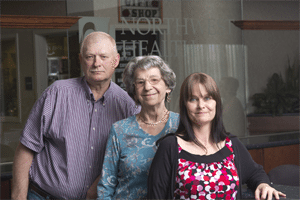Five Bentonville Stroke Patients Receive Clot Buster
| Rhonda Smith’s stroke was about as severe as they come. Her chance for survival was slim without immediate access to a stroke neurologist who could correctly diagnose her type of stroke so she could receive a powerful clot-dissolving drug.

Randy Snoderly, Wilma Parsons and Rhonda Smith are three of the five stroke patients treated with the clot buster t-PA in one month at Northwest Medical Center-Bentonville.
Fortunately, the 42-year-old wife and mother was working just a block away from Northwest Medical Center – Bentonville, which in January 2011 had joined the AR SAVES (Arkansas Stroke Assistance through Virtual Emergency Support) telemedicine program.
As part of the AR SAVES program, Northwest Medical Center – Bentonville and 35 other Arkansas hospitals have 24-hour access to a stroke neurologist via telemedicine, or live two-way video. This makes it possible to treat patients with the clot-busting drug t-PA (tissue plasminogen activator), which must be administered within 4.5 hours of a stroke’s onset.
Committed to AR SAVES
Without the AR SAVES partnership, stroke patients
admitted to small hospitals often miss the opportunity for this life-saving care. In the five years prior to joining AR SAVES, only one stroke patient at Northwest Medical Center-Bentonville received t-PA, said Pam Adams, R.N., stroke coordinator for the hospital. After joining AR SAVES, the Bentonville hospital was able to administer the drug to nine patients through November 2011.

(From left) Pam Frachiseur, R.N.; Tara Stoicescu; Vickie Thomas, R.N.; and Pam Adams, R.N., are part of the stroke team at Northwest Medical Center-Bentonville.
That was a substantial increase, but then in December the hospital successfully treated five patients with t-PA, including Smith.
“It was unprecedented for the six years I’ve been here to have that many stroke patients with a good outcome in one month,” Adams said.
Julie Hall-Barrow, Ed.D., AR SAVES director, said the Bentonville hospital, led by Chief Operating Officer Tripp Smith, has shown an enthusiastic commitment to the AR SAVES program.
“Telemedicine and t-PA are the hallmarks of AR SAVES, but it requires tremendous coordination and effort to achieve the best outcomes for patients,” Hall-Barrow said. “With five good outcomes in one month, Northwest Medical Center – Bentonville physicians and staff demonstrated that their system is always primed to function at a high level. Their story speaks volumes for the life-saving capacity of AR SAVES.”
Adams said the staff has trained diligently to prepare for AR SAVES, and they all take pride in working to ensure the fastest possible diagnosis. The goal is to have patients diagnosed and ready for t-PA within one hour of their arrival. Although patients can receive t-PA at 4.5 hours, the sooner they receive it the better their chances of survival and avoiding long-term disabilities.
“As soon as a stroke patient arrives, the doctor does a brief evaluation and the gurney is wheeled directly back to the CT scanner, which we’ve already cleared of nonemergency patients,” Adams said. “By bypassing the emergency room we save 20-25 minutes.”
Grateful Patients
Randy Snoderly of Garfield, one of the five December patients, received t-PA within 33 minutes of his arrival at the hospital, a record time. “Everything just fell into place,” Adams said.
Snoderly, 60, was at work preparing to do inventory when he felt numbness in his right foot that quickly became paralysis of his right side, and he was unable to speak.
“The guys I was working with said I was having a stroke and someone called 9-1-1,” said Snoderly, who expressed gratitude that the hospital could provide treatment. “My speech is back to normal, but I still get really tired.”
Wilma Parsons, 79, also one of the five December patients, was about to put clean sheets on her bed when she was forced by dizziness to sit down. Then she realized she couldn’t speak.
“My husband hollered, and when I didn’t answer he came to see what was wrong,” said Parsons, of Bella Vista. “I just put my hands out and grabbed him and hugged him. He said, ‘I think it’s time to call 9-1-1.’”
Parsons left the hospital a few days later, and without therapy, within four months she had returned to all of her normal activities except driving. The use of telemedicine impressed her.
“That is amazing; I never dreamed that we could do things like that,” she said. “I am very thankful for it, and I let them know that when I was leaving the hospital.”
‘Christmas Miracle’
For Smith, a complete recovery from her massive stroke was still ongoing four months later, with physical and speech therapy part of her routine. But she was ahead of schedule in speech therapy and able to drive short distances.
Given the severity of her stroke, she feels lucky, saying some call her outcome a Christmas miracle. Based on the National Institutes of Health (NIH) Stroke Scale, Smith’s stroke scored a 25, which falls in the most severe of four categories.
“I was told I should have been buried,” Smith said. “When I saw the CT scan of my brain during my three-month follow-up, I started bawling. It was horrible; there was just nothing on that side. I am so thankful they gave me the t-PA.”
Without t-PA, Adams said, Smith would have required total care had she lived. The other four patients had moderate strokes, which still would have been devastating.
“They would have had major deficits, such as being unable to speak and unable to use one side of their body,” Adams said. “AR Saves has definitely made a difference.”
